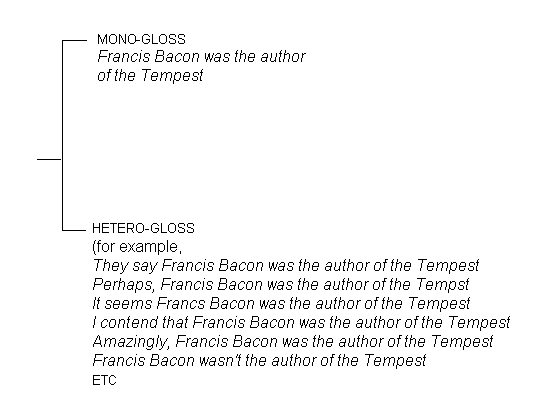


In the previous sections I have set out in general terms the heteroglossic orientation with informs the remodelling of inter-subjective positioning from which the formulation of ENGAGEMENT is derived. In the following sections I describe some of the key elements of the ENGAGEMENT system.
As I have indicated, under a heteroglossic approach, we see utterances as necessarily invoking, acknowledging, responding to, anticipating, revising or challenging a range of more or less convergent and divergent alternative utterances and hence social positions. This perspective thus provides a potent counter to the common-sense notion that certain utterances are interpersonally neutral and hence `factual' or `objective' while others are interpersonally charged and hence `opinionated' or `attitudinal'. Under systemic functional perspectives, of course, all utterances are analysed as simultaneously ideational and interpersonal - there is no utterance which is without interpersonal value. Nevertheless, the influence of the common-sense notion of the `fact' is widespread and it may be tempting to see some utterances as more interpersonal than others. Under the heteroglossic orientation, however, we are reminded that even the most `factual' utterances, those which are structured so as to background interpersonal values, are nevertheless interpersonally charged in that they enter into relationships of tension with a related set of alternative and contradictory utterances. The degree of that tension is socially determined. It is a function of the number and the social status of those alternative socio-semiotic realities under which the utterance at issue would be problematised. Accordingly, the difference between the utterance `Francis Bacon was the author of The Tempest.' and `In my view, Francis Bacon was the author of The Tempest.' is not one of `fact' versus `opinion' but of the degree to which the utterance acknowledges the intertextual or dialogic context (in Bakhtin's sense) in which it operates. The distinction, therefore, can be represented in terms of heteroglossic negotiation - the first utterance (the so-called `fact') ignores or down-plays the possibility of heteroglossic diversity by dint of its lexico-grammar while the second actively promotes that possibility. Alternatively, we can say the first denies or ignores the intertextual heterogeneity in which it operates while the second asserts it.
The key insight here is that the positive declarative is not any less interpersonal and positioning than the array of alternatives by which the heteroglossic diversity is invoked, acknowledged or fended off . Rather, in using the positive declarative, the writer adopts a particular rhetorical strategy towards the possibility of heteroglossic diversity, namely of either choosing not to directly acknowledge that possibility, or of assuming a homogeneous rather than a heterogeneous speech community. This is not, of course, a novel position and there is a long-standing debate in the literature over the `modal' status of the so-called `bare declarative'. Thibault, for example, adopts a similar position to mine in his `Mood and Eco-social dynamics' paper (1997). He states, for example, `no utterance is free from subjective presencing of the speaker'(1997: 53).
The fundamental choice in the system of ENGAGEMENT, therefore, is between what we might term the mono-glossic option (the so-called `bare' declarative) and the network of resources by which we directly inscribe the possibility of social heterogeneity into the text.

Figure 2: ENGAGEMENT entry point